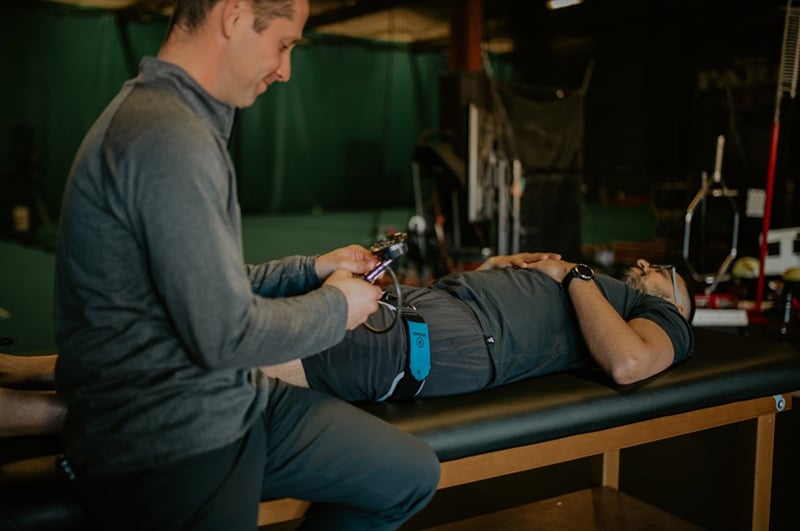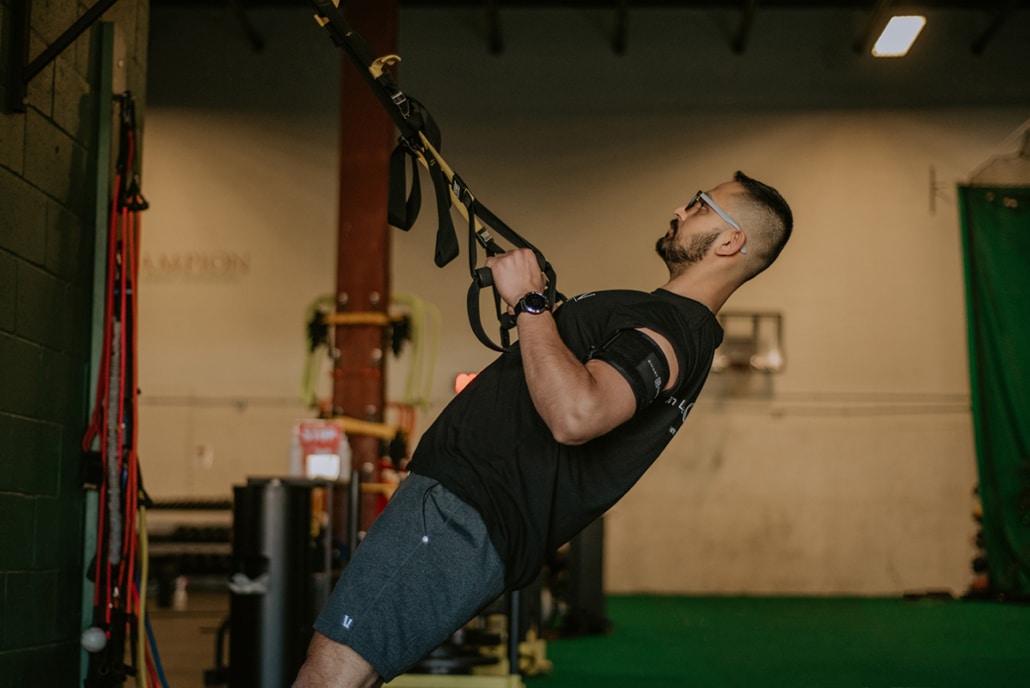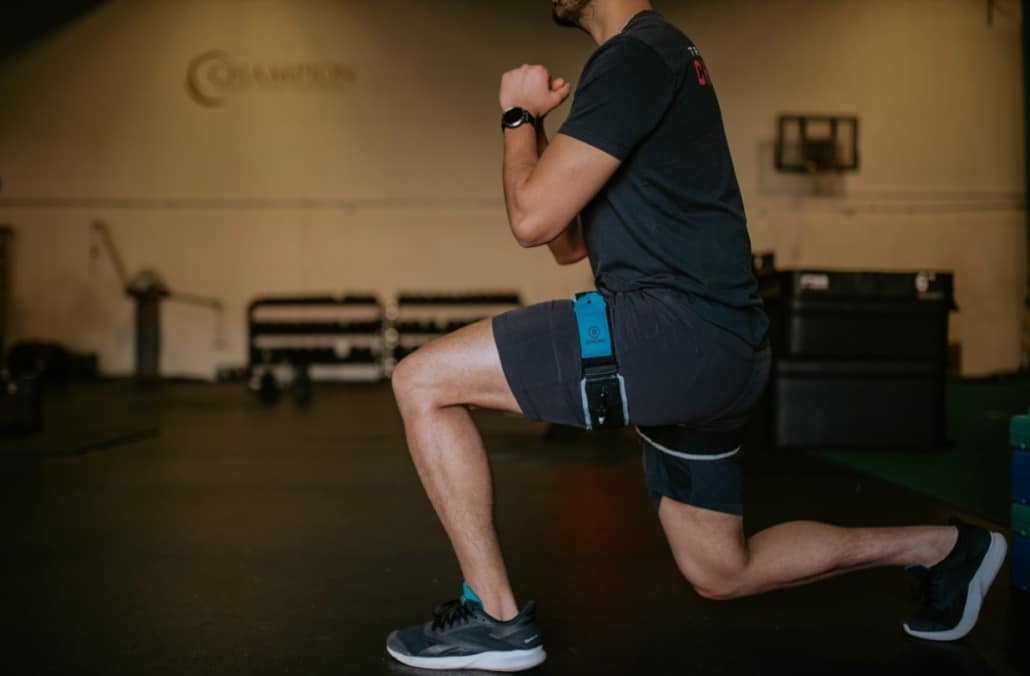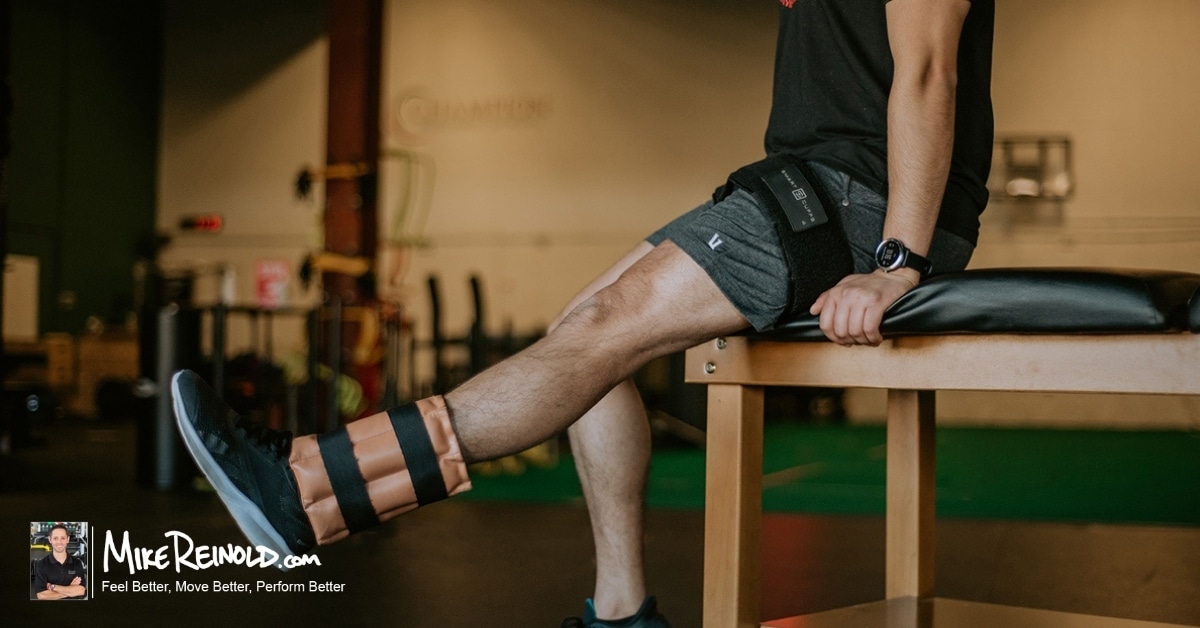In this guide, I’m going to share everything you need to know about blood flow restriction training, also known as occlusion training, or simply BFR training.
Here’s everything we currently know about the science of blood flow restriction training, including some of the science we know about the safety and effectiveness of BFR training. Keep reading or jump to the section below:
Table of contents
- What is Blood Flow Restriction Training?
- How Do Muscles Get Stronger?
- How Does Blood Flow Restriction Training Work?
- Blood Flow Restriction in Physical Therapy
- Does Blood Flow Restriction Training Work?
- Is Blood Flow Restriction Training Safe?
- What are the Contraindications to BFR Training?
- Do You Need Certification to Perform Blood Flow Restriction Training?
- What Are the Best Blood Flow Restriction Cuffs?
- How to Start Using Blood Flow Restriction Training
What is Blood Flow Restriction Training?
Blood flow restriction training is a technique that can be used to perform exercises with a reduced amount of blood flow to the arm or leg. This is often performed using a cuff or strap placed tightly around the limb to reduce, but not completely occlude, blood flow.
The benefit of blood flow restriction training is to allow the person to exercise with lower intensity, but, still have the benefits of high-intensity training. This is very exciting.
- Read More: The Best BFR Bands, Cuffs, and Equipment

Unless you’ve been living under a rock, we’re guessing you’ve heard of blood flow restriction training, and maybe you’re even using it. Its popularity exploded recently, mostly due to the media and stories of pro athletes who swear by it, like many “fly by night” treatments.
The thing is though, BFR isn’t new or just a fad.
BFR research has been going on for over 20 years now, and we’re here to tell you – it’s solid. And as we continue to learn more and more, it continues to show promise.
When I first heard of blood flow restriction training, I have to admit I was a little skeptical. Over the years, I’ve seen a lot of fads come and go in our professions.
For example, let’s play a little game…
As fast as you can, can you think about something we do in the rehabilitation or fitness professions that does NOT have a strong scientific rationale or clinical research to support its use?
Waiting… waiting…
Pretty easy isn’t it? There’s a whole lot of them to be sure.
Now, let’s think of some that are exactly the opposite. What DOES have a strong scientific rationale and clinical evidence?
Hopefully, the first one you think of is exercise and strength training. There’s pretty solid evidence from a scientific standpoint, as well as clinical research, to support strength training.
Well, another modality that must be in that discussion is blood flow restriction training.
I’m not one to jump on a bandwagon, but as more and more evidence continues to be published, it’s starting to become clear that BFR is something we should be considering.
So, how does BFR training work? Let’s dig into it a little.
How Do Muscles Get Stronger?
It’s probably a good idea to start with the basics of how muscles get bigger and stronger.
Simply put, muscles adapt through neural, mechanical, and metabolic mechanisms.
Many of these mechanisms involve multi-step pathways that will likely put you to sleep if we go into too much detail in this post, but they are nevertheless important to understand.
In a nutshell, it all comes down to load and volume.
From a hormonal standpoint, testosterone increases with high-load, multi-joint exercises, while growth hormone increases with high-volume, multi-joint exercises.
That’s an important concept…
High-volume, moderate-intensity increases growth hormone, but low-volume, high-intensity does not.
Insulin-like growth factors (IGF’s), myogenic stem cells (MSC’s), Vascular Endothelial Growth Factor (VEGF), and the mTORC1 pathway are all activated during normal high-load training.
Notice above that the key term is “high load.” We need high loads to get strong.
In sum, these various pathways and “ingredients” are vital for muscle growth.
How Does Blood Flow Restriction Training Work?
There are a number of proposed mechanisms for how BFR works.
Our current understanding is that blood flow restriction training works by the indirect effect of metabolite accumulation and the hypoxic environment from exercising with limited arterial flow. This causes greater fatigue, muscle activation, and also anabolic signaling pathways that lead to muscular adaptations compared to exercise without BFR.
So, if we know that getting strong requires a combination of load and volume, what do we do in cases where people are not appropriate for high loads or can’t tolerate them? For example, following an injury or surgery. Or maybe with someone training at home without access to weights to accomplish high loads.
This is where BFR training can be helpful.
Blood flow restriction training can be a tremendous adjunct to training because these same muscle-building ingredients happen in a low-load environment.
In cases of immobilization or atrophy, muscle protein degradation takes place. With BFR training using low loads, and in some studies no load at all, multiple pathways are activated to increase muscle protein synthesis.
When talking about the hypoxic environment and the mechanisms associated with it, it’s a “snowball effect.” The reduced oxygen in the area accelerates fatigue and the recruitment of more high-threshold motor units. In other words, “all hands on deck” in the muscle. The lowered pH from the hypoxic environment is a hypertrophic stimulus.
There is also an added benefit of the “muscle pump” from cellular swelling. In effect, the compression causes metabolites to accumulate, and we’ve already discussed the benefits of the increase in metabolites. Essentially, when the compression is reduced or relieved, the floodgates essentially open, bringing all those “muscle-building ingredients” to the muscle.
Blood Flow Restriction in Physical Therapy

No matter what injury you’re dealing with, muscle atrophy and weakness are common impairments.
Methods to address these impairments are often performed right away. Neuromuscular electrical stimulation, biofeedback, isometrics, and cross-education are just a few methods we use to start strengthening early while the tissue is compromised.
Unfortunately, in the early healing phases, heavy loads are not appropriate because they may overload and damage the healing tissue.
This becomes an issue when someone is trying to recover from an injury and gain strength at the same time.
Resistance training guidelines encourage high loads that are more than 60% of one maximal repetition (1RM) for 8-12 repetitions.
We need proper loads to get the adaptations we seek. Further complicating matters is that 1RM testing in the early phases of rehabilitation isn’t appropriate. There are estimation models for 1RM, but they are not ideal.
BFR provides an option for attenuating atrophy following injury as well as increasing strength in a low-load environment. Essentially, training loads of 20-30% 1RM with 15-30 repetitions per set. This is much more applicable to training with healing tissue that is not yet ready to accept more intense loading.
Does Blood Flow Restriction Training Work?
Numerous research has been published documenting the effectiveness of BFR training.
Blood flow restriction training has been shown to help attenuate atrophy, enhance hypertrophy, increase strength, and improve aerobic capacity, all in a low-load environment.
That all sounds great, but what about diagnosis-specific evidence?
If there are so many benefits of blood flow restriction training, we’d expect positive outcomes on specific diagnoses, right? Well, that would be correct!
BFR After ACL Reconstruction
We know from years of research that the quadriceps lose strength after knee surgeries like ACL reconstruction. Fortunately, BFR is well-suited to help with strength and hypertrophy losses following ACL reconstruction and a number of studies have shown a benefit from the use of BFR.
Now, while there may not be a ton of BFR studies for other specific diagnoses, intuitively, every post-op knee needs quad strength and hypertrophy, so you should feel good that similar benefits would be realized.
BFR for Knee Pain
Arguably, one of the main reasons that people come to see us across all populations is pain relief. It stands to reason that higher loads might aggravate an already irritable tissue (or patient!), making BFR training with low loads appealing.
A number of studies have shown the benefit of BFR on pain reduction in patellofemoral pain, knee osteoarthritis, and function after ACL reconstruction and knee osteoarthritis.
BFR After Immobilization
We all know the detrimental effects that immobilization has on a muscle. You’ve seen it in patients (and maybe yourself if you’ve had surgery!).
You guessed it – BFR can help even in cases of immobilization. So even if your patient is stuck in bed or can’t do much, BFR can help! How amazing is that?
BFR in the Geriatric Population
If athletes aren’t your population and you see more mature or geriatric patients, great news, BFR helps this population as well.
Several studies have found that BFR has helped with pain relief and functional scores in older patients.
Certainly, you should take more precautions (see below) and know who you’re treating in this population, but if you think about it, if you can get the benefits of strength training with lower loads, that’s a win-win!
The only issue we’ve seen with this population is the discomfort, and it takes a little more convincing in our experience.

Is Blood Flow Restriction Training Safe?
Before we dig into safety, it’s important to note that anything can be unsafe in the wrong hands when used inappropriately, or in the wrong population.
That being said, BFR training has been shown to be safe.
BFR has been used in a variety of musculoskeletal pathologies and to date, has not resulted in serious adverse events for those who don’t have contraindications to BFR training.
Common side effects with BFR training are often short-lived and include numbness, bruising, discomfort, petechial hemorrhage, skin abrasions, and delayed onset muscle soreness (DOMS).
These are usually not concerning. However, caution should be noted with patients with cardiac conditions or clotting concerns.
Luckily, a recent review showed that the risk of clots, or DVT’s, is extremely low.
At this time, we recommended that BFR training commence about two weeks after surgery to help reduce the risk of adverse events.
You should also be sure to use the best BFR cuffs and equipment in order to maximize safety. There are a lot of inferior products flooding the market now.
What are the Contraindications to BFR Training?
Based on the above safety guidelines, the contraindications to BFR are centered around those with vascular insufficiencies or cardiac implications.
There can be an increase in cardiac stress due to increased stroke volume and heart rate from the body trying to get arterial blood to tissues.
People with hypertension, diabetes, a history of stroke or DVT, cardiac disease, active infections, pregnancy, clotting disorders, or other vascular insufficiencies (like varicose veins) are contraindications.
That said, it is advisable to speak with the primary care physician to determine if a patient is appropriate for BFR training. If you think about it though, these are often contraindications for a number of other modalities and treatment approaches.
Basically, use your head.
Clinical reasoning and decision-making are just as important with BFR as with any other treatment approach.
Do You Need Certification to Perform Blood Flow Restriction Training?
As with anything new, there are always several misconceptions that surround BFR training. One that has specifically been reported is the need for a specific certification to start performing BFR training.
The short answer is no, you do not need a certification to use blood flow restriction training. BFR is within the scope of practice for physical therapists and athletic trainers. Local authorities may have different guidelines, so it’s always your best bet to check your state practice acts to make sure you can use BFR.
Much like any other intervention you use, it’s important that you educate yourself on the mechanism and execution of the treatment, as well as absolute and relative contraindications.
What Are the Best Blood Flow Restriction Cuffs?
There are many different blood flow restriction bands, cuffs, and devices on the market: some good, and some bad.
There are several factors to consider when choosing the best BFR cuffs. I have a detailed article that tells you more, so be sure to read my full guide for all my recommendations:

How to Start Using Blood Flow Restriction Training
Now that you understand a little bit about the science of blood flow restriction training, I’m sure you want to learn more about how you can safely and effectively start using BFR.
Luckily, learning about BFR doesn’t need to be complicated or expensive! You can even get started with affordable blood flow restriction cuffs.
Dan Lorenz and I have teamed up to create an online blood flow restriction training course teaching you exactly how we use BFR training for both rehabilitation and training.
We believe that BFR is a technique we should all be using, the science is there. So we want to help you quickly and easily learn everything you need to know to get started with BFR training.
We’ll cover the history and science in detail, discuss the safety and efficacy, then show you exactly how we select BFR cuffs, determine the appropriate amount of pressure, and then incorporate them into our programs.
You’ll be able to start using BFR training safely and effectively right away.
This article was co-written with me by Dan Lorenz, my co-author for our new Blood Flow Restriction Training online course. Dan Lorenz, DPT, PT, ATC, LAT, CSCS is the Director of Sports Medicine at Lawrence Memorial Hospital/OrthoKS in Lawrence, KS. Dan specializes in performance enhancement, strength training, and blood flow restriction training. He has been published several times in peer-reviewed journals, has authored and co-authored a number of home study courses and book chapters, and has been an invited speaker numerous times at local, state, and national conferences on these topics throughout the U.S.








